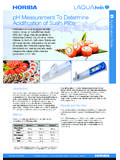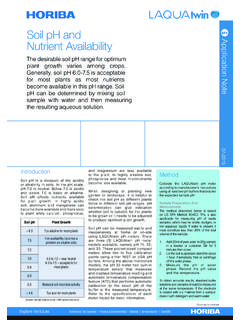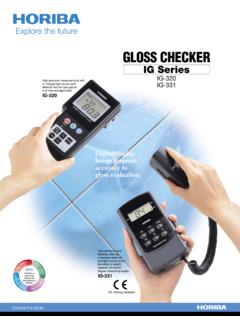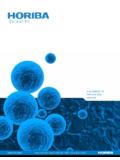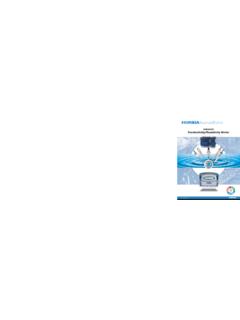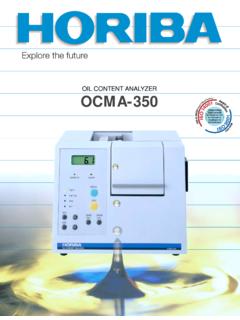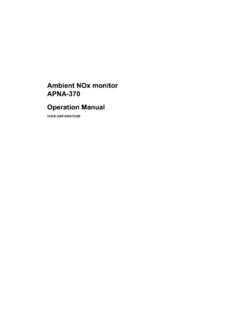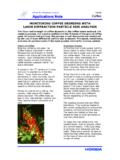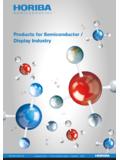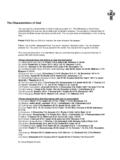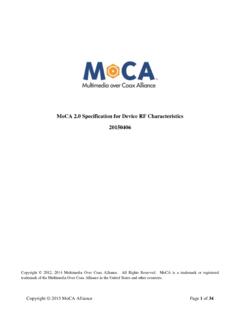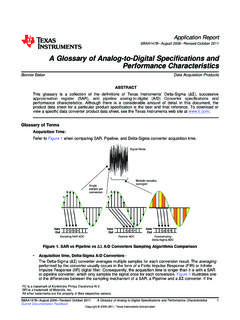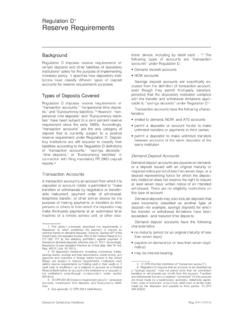Transcription of Glossary for Sample Reports for CAMSIZER
1 CAMSIZER characteristics Basis of definition DIN 66141 Retsch Technology GmbH Rheinische Strasse 43 42781 Haan Germany phone: +49 2129 5561-0 fax: +49 2129 5561-87 e-mail: characteristics Particle size distribution: xarea Particle diameter calculated by the area of particle projection xarea = A4 Diameter of the area equivalent circle with a volume of a sphere with the diameter of xarea xc min Width, Breadth particle diameter which is the shortest chord of the measured set of maximum chords of a particle projection (for results close to screening/sieving) xMa min Width, Breadth particle diameter, which is the shortest Martin diameter, which is dividing the area of the particle projection into two halves (for results close to screening/sieving) xFe min Width, Breadth particle diameter which is the shortest Feret diameter of the measured set of Feret diameter of a particle projection xFe max Length particle diameter which is the longest Feret diameter of the measured set of Feret diameter of a particle (for results close to microscopy)
2 Xlength Length particle size, which is calculated from the longest Feret-diameter and the smallest chord or Martin diameter of each particle projection 2min2maxlengthcFexxx = (suitable for display of length distributions of cylinders, which are orientated by a guidance sheet ( to substitute optical measurement systems like light table, calliper, microscope or static image analysis systems) xlength is limited to the smallest xc min of this particle xlength2 Length particle size, which is calculated from the longest Feret-diameter and the smallest chord or Martin diameter of each particle projection 2min2maxleng2cFexxx = xstretch Length particle size, which is calculated from the area of the particle projection of each particle divided by the smallest diameter (smallest Martin diameter) of the particle projection, interesting for bended extrudates and short extrudates xStretch is limited to xMa min of this particle xstretch2 Length particle size, which is calculated from the area of the particle projection of each particle divided by the smallest diameter (smallest of all maximum chords) of the particle projection, interesting for bended extrudates and short extrudates Q3(x) Cumulative distribution (% passing), based on volume: volume proportion of particles smaller than x in proportion to the total volume 1-Q3(x) Cumulative distribution of residue 1-Q3(x), based on volume p3(x1,x 2) Fractions p3 (x1,x2) volume proportion of particles in the range (x1,x2): )x(Q)x(Q)x,x(p1323213 = q3(x) Density distribution q3(x) based on volume: 1.)
3 Derivative of Q3(x) dxxdQxq)()(33= Q0(x) Cumulative distribution Q0(x), based on number of particles: number of particles smaller than x in proportion to the total number of particles 1-Q0(x) Cumulative distribution of residue 1-Q0(x), based on number of particles p0(x1,x2) Fractions p0(x1,x2) - number of particles in the range (x1,x2): )x(Q)x(Q)x,x(p1020210 = q0(x) Density (frequency) distribution q0(x), based on number of particles: 1. Derivative of Q0(x) dxxdQxq)()(00= characteristics : Q3(x) Q3 value, whereat a given particle diameter x is reached, based on volume x (Q3) x value whereat which a given Q3 value is reached, based on volume SPAN3 Span value, based on volume: )Q(x)Q(x)Q(xSpan2,31,33,33 = Here the first index indicates that the values are based on volume. In the program the first index has been left off, since for SPAN3 and SPAN0 the same Q(x) values are used.
4 CAMSIZER characteristics Basis of definition DIN 66141 Retsch Technology GmbH Rheinische Strasse 43 42781 Haan Germany phone: +49 2129 5561-0 fax: +49 2129 5561-87 e-mail: characteristics U3 Non-uniformity, based on volume: 10603xxU= x10: x value for Q3 = 10 % x60: x value for Q3 = 60 % Q0 (x) Q0 value, whereat a given particle diameter x is reached, based on number x(Q0) x value, whereat a given Q0 value is reached, based on number SPAN0 Span value, based on number of particles )()()(2,01,03,00 QxQxQxSpan = Here the first index indicates that values are based on the number of particles. In the program the first index was left off as for SPAN3 and SPAN0 the same Q values are used. U0 Nonuniformity, based on number of particles 10600xxU= x10: x value for Q0 = 10 % x60: x value for Q0 = 60 % Indirect determination of the specific surfaces Sv and Sm: SV Specific surface particles all of olumevparticles all of surfaceSV= Sm Specific surface for a given specific density particles all of assmparticles all of surfaceSm= RRSB characteristics : n Slope of the RRSB line d' x value, whereat the line reaches a value of correlation Correlation between the RRSB line and Q(x) in the range between Q1 and Q2 Shape characteristics : xFe xFe max xFe min Feret diameter xFe Distance between two tangents placed perpendicular to the measuring direction.
5 For a convex particle the mean Feret diameter (mean value of all directions) is equal to the diameter of a circle with the same circumference. xFe The longest Feret diameter out of the measured set of Feret diameters. The shortest Feret diameter out of the measured set of Feret diameters. xMa xMa min Martin diameter xMa Length of the area bisector in the measuring direction xMaarea bisector The shortest Martin diameter out of the measured set of Martin diameters. xFe max A/2 xMa min A/2 CAMSIZER characteristics Basis of definition DIN 66141 Retsch Technology GmbH Rheinische Strasse 43 42781 Haan Germany phone: +49 2129 5561-0 fax: +49 2129 5561-87 e-mail: characteristics xc xc min maximum chord xc in measuring direction xC The shortest chord out of the measured set of max. chords xc. = breadth/width, which is very close to sieving.
6 SPHT0,2,3 Sphericity 24 PASPHT = = Circularity2 (ISO 9276-6) P measured perimeter/circumference of a particle projection A measured area covered by a particle projection For an ideal sphere SPHT is expected to be as 1. Otherwise it is smaller than 1. Symm0,2,3 Symmetry +=213,2,0min121rrSymm r1 und r2 are distances from the centre of area to the borders in the measuring direction. For asymmetric particles Symm is < 1. If the centre of area is outside the particle 0rr21< Symm is < 21 Marrx+= Symm is minimum value of measured set of symmetry values from different directions b/l0,2,3 Aspect ratio maxmin3,2,0/Fecxxlb= ; xc min and xFe max out of the measured set of xc and xFe values (b/l)rec 0,2,3 () =Fecrecxxlbmin/3,2,0; min quotient of perpendicular xc and xFe out of the measured set of xc and xFe values. B/L0,2,3 maxmin3,0/FeFexxLB=; xFe min and xFe max out of the measured set of xFe values xc min (B/L)rec 0,2,3 () =213,0min/FeFerecxxLB ; min quotient of perpendicular xFe1 and xFe2 out of the measured set of xFe values.
7 Xp= xmean The Feret diameter, the Martin diameter, the max. chord and the sphericity for the various size classes are determined by calculating a mean value, based on the number of particles within a size class: ==niixnx11 As the objects within a class can be distributed unevenly, the mean equivalent diameter of circles equal in area, xp, should be used as reference value for class-related information. PD0, PD3 Number of particle detections, measure of the statistical reliability of the shape characteristics . The larger PD the more reliable is the value of xFe, xMa, xc and SPHT. Sigma(v)0 Standard deviation of the ratio = =niivnvSigma12)1(1)( with the ratio )x,xmin()x,xmax(vcFecFei= of the particle no. i, in which the measuring directions of the Feret diameter and the maximal chord are perpendicular to each other. Q0(SPHT)= NSP0 Q3(SPHT)= NSP3 Proportion of non-spherical particles, whose sphericity is smaller than a given threshold; based on number of particles or on volume Q0/2/3; Symm; b/l, (b/l)(rec) B/L, etc.
8 Proportion of particles or volume, whose symmetry, or various b/l-ratios is smaller than a given threshold Mv0/2/3(x) Mean value of a chosen characteristic, weighted; x1,r = x qr(x) x Sigma(x) Standard deviation (x) from the mean value Mv(x) Conv0/2/3 Convexity = (square root) ratio of real area of the particle projection and convex area of particle projection (as if a rubber band was put around the particle projection) Trans0/2/ 3 Transa0/2/ 3 Transb0/2/ 3 Q0/2/3(trans) Q0/2/3(transa) Q0/2/3(transb) Trans(parency) = ratio of the bright area within the particle projection divided by complete filled particle projection Q(Transparency) = amount of Sample below a threshold of the ratio between bright area of particle projection divided by complete filled particle projection. Characteristic Trans AATrans1= A= Area of the filled particle projection (without pixels at the edge of the projection).
9 A1= Area within the particle projection which has a brightness larger than Thresh1 . Thresh1 = Imin + (Imax Imin) CAMSIZER characteristics Basis of definition DIN 66141 Retsch Technology GmbH Rheinische Strasse 43 42781 Haan Germany phone: +49 2129 5561-0 fax: +49 2129 5561-87 e-mail: characteristics Characteristic Trans a AATrans2= A= Area of the particle projection (without pixels at the edge of the projection). A2= Area within the particle projection which has a brightness larger than Thresh2 . Thresh2 = Imin + (Imax Imin) Characteristic Trans b AIIdAIyxITransbfixAfix)()),((max3 = A= Area of the particle projection (without pixels at the edge of the projection). A3= Area within the particle projection which has a brightness larger than Thresh3 . Thresh3 = Ifix + (Imax Ifix) Imin = minimum brightness within particle Imax = maximum brightness of particle Ifix = minimum brightness of the camera Trans and Trans a are depending on the brightness of the particle projection.
10 Calculation of Transparency is done with the histogram of the particle brightness and the brightness of the surrounding area. Optional characteristics : rD relative Density, mass of Sample divided by the volume of the Sample measured with the CAMSIZER AFS American Fineness number, AFS number is a sand specific requirement and it is a figure that results in one number for a measured Sample . The formula for this number is: =iiipMpAFS333* Where:p3i is the fraction of the material in the class i and M3 is an fixed multiplication factor for each class. There is a connection between the ASTM Mesh number and this M3 multiplication factor (we do not know it). Example: Class Fraction p3 Multiplication factor M3 P3 * M3 1 0,71 - 15 - 0,71 0,5 0,75 25 19 0,5 0,355 8,70 35 305 0,355 0,25 28,60 45 1287 0,25 0,18 30,05 60 1803 0,18 0,125 5,90 81 478 0,125 0,09 1,00 118 118 0,09 0,063 0,30 164 49 0,063 0,02 0,35 275 96 75,65 4155 5592,5465,754155 ==AFS SGN Size Guide Number Calculated diameter of the average particle , expressed in millimeters and multiplied with 100 (for example: d50 = mm => SGN = ) 50x 100 SGN = with %)50Q(xx350== in mm The calculation of SGN is based on the following size classes: , , , , , , , , , , If x50 falls into one of these size classes, than x50 is an interpolated value from the Q3 value of the next lower and the next higher sieve.
